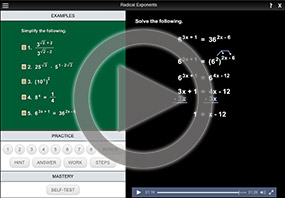Solving Exponential Equations from the Definition
Purplemath
To solve exponential equations without logarithms, you need to have equations with comparable exponential expressions on either side of the "equals" sign, so you can compare the powers and solve. In other words, you have to have "(some base) to (some power) equals (the same base) to (some other power)", where you set the two powers equal to each other, and solve the resulting equation. For example:
-
Solve 5x = 53
Since the bases ("5" in each case) are the same, then the only way the two expressions could be equal is for the powers also to be the same. That is:
x = 3
Content Continues Below
This solution demonstrates the logical basis for how this entire class of equation is solved: If the bases are the same, then the powers must also be equal; this is the only way for the two sides of the equation to be equal to each other. Since the powers must be the same, then we can set the two powers equal to each other, and solve the resulting equation.
-
Solve
Since the bases are the same, then I can equate the powers and solve:
1 − x = 4
1 − 4 = x
−3 = x
Then my solution is:
x = −3
Not all exponential equations are given in terms of the same base on either side of the "equals" sign. Sometimes we first need to convert one side or the other (or both) to some other base before we can set the powers equal to each other. For example:
-
Solve 3x = 9
Since 9 = 32, this is really asking me to solve:
3x = 32
By converting the 9 to a 32, I've converted the right-hand side of the equation to having the same base as the left-hand side. Since the bases are now the same, I can set the two powers equal to each other:
x = 2
-
Solve
In this case, I have an exponential on one side of the "equals" and a number on the other. I can solve the equation if I can express the "27" as a power of 3. Since 27 = 33, then I can convert and proceed with the solution:
32x−1 = 27
32x−1 = 33
2x − 1 = 3
2x = 4
x = 2
If I'm not sure of my answer, or if I want to check it before I hand it in (on, say, a test), I can check it by plugging it back into the original exercise. The power on the left-hand side of the original equation would simplify as:
2x − 1 = 2(2) − 1
= 4 − 1 = 3
And 33 = 27, which is the right-hand side of the original equation. Then my (confirmed) solution is:
x = 2
Affiliate
Affiliate
As you can probably tell, you will need to get good with your powers of numbers, such as the powers of 2 up through 26 = 64, the powers of 3 p through 35 = 243, the powers of 4 up through 44 = 256, the powers of 5 up through 54 = 625, the powers of 6 up through 63 = 216, and all the squares.
Don't plan to depend on your calculator for everything, because having to find every value in your calculator can waste a lot of time. You'll want to have a certain degree of facility (that is, a certain degree of familiarity and speed) by the time you reach the test, so familiarize yourself with the smaller powers now.
-
Solve
This exercise works just like the previous one:
So my answer is:
x = −1, 4
-
Solve
This equation is similar to the previous two but is not quite the same, because 8 is not a power of 4. However, both 8 and 4 are powers of 2, so I can convert. The right-hand side is easy:
8 = 23
The left-hand side is a bit messier:
Now that I've re-stated both sides as powers on 2, I can solve:
Content Continues Below
-
Solve
Negative exponents can be used to indicate that the base belongs on the other side of the fraction line. Since 64 = 43, then I can use negative exponents to convert the fraction to an exponential expression:
Using this, I can solve the equation:
-
Solve
In order to be able to solve this one, I first need to recall that square roots are the same as one-half powers, and convert the radical to exponential form. Then I can solve the equation:
Then my answer is:
The following is an example of a common type of trick question:
-
Solve 2x = −4
Think about it: What power on the positive number "2" could possibly yield a negative number? A number can never go from positive to negative by taking powers; I can never turn a positive two into a negative anything, four or otherwise, by multiplying two by itself, regardless of the number of times I do the multiplication. Exponentiation simply doesn't work that way. So the answer here is:
no solution
URL: https://www.purplemath.com/modules/solvexpo.htm
Select a Course Below
Standardized Test Prep
Homeschool Math
© 2024 Purplemath, Inc. All right reserved. Web Design by ![]()



